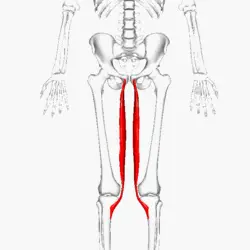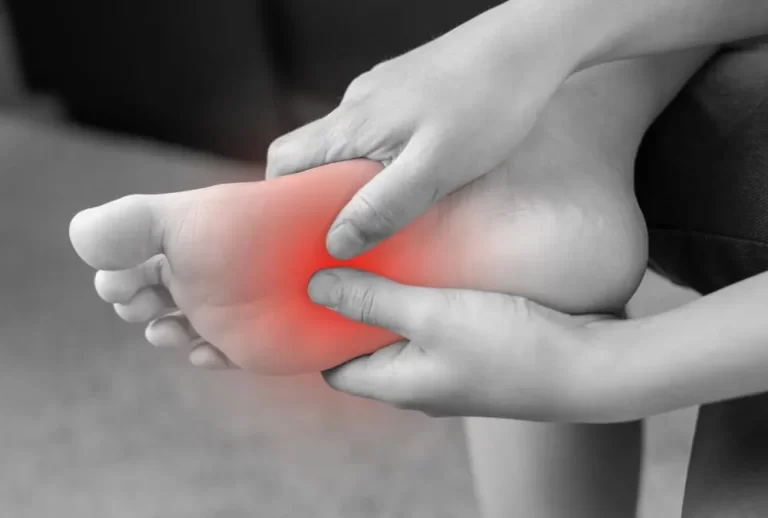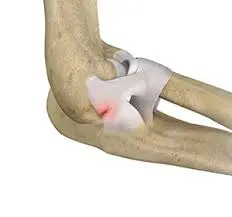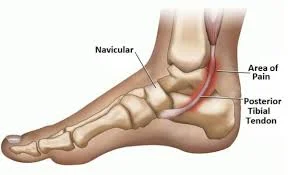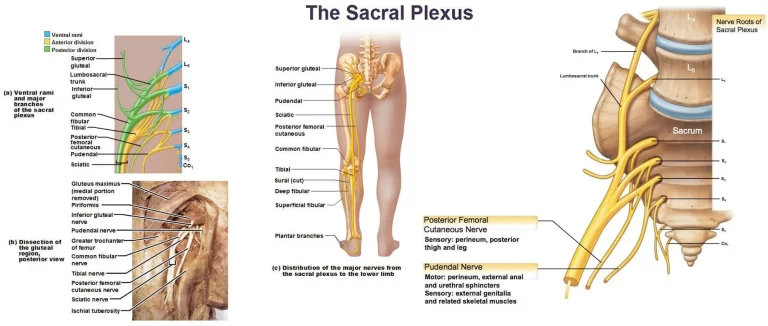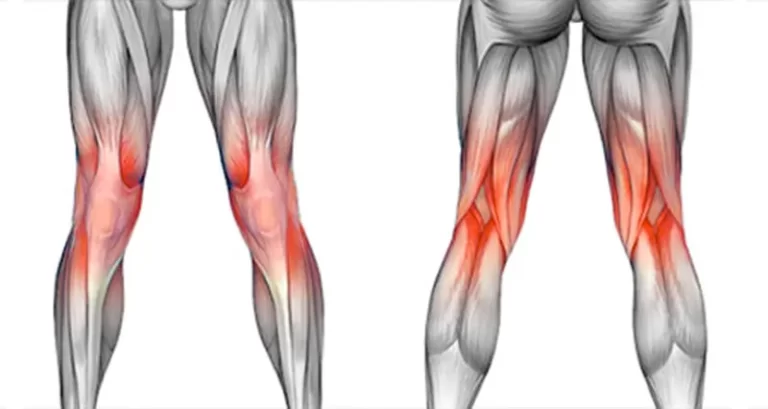Gracilis Muscle Pain
Gracilis muscle pain refers to discomfort or soreness in the long, slender muscle located in the inner thigh. This pain is often caused by overuse, strain, or injury from activities involving repetitive leg movements, such as running or cycling.
It may result in inner thigh stiffness, soreness, and difficulty with leg motion, requiring proper diagnosis and management for effective relief.
What is the Gracilis muscle pain?
- Pain where the inside of the upper thigh and the belly meet is known as gracilis muscle pain.
- However, there are other reasons of groin pain besides muscle pain, and the way that gracilis pain is experienced can differ. The symptoms and underlying cause of the pain, as well as whether the pain is experienced by a child or an adult, male or female, will determine the diagnosis and course of treatment.
Anatomy of the Gracilis muscle.
- Origin: inferior ischiopubic ramus
- Insertion: The gracilis muscle attaches to the medial tibia at the pes anserinus after descending nearly vertically down the leg.
- Nerve supply: obturator nerve (L2-L4)
- Blood supply: medial circumflex femoral artery
- Gracilis’ action
- Adduction around the hip joint and weak thigh flexion only serve to support the other, stronger thigh adductors.
Common causes of Gracilis muscle pain
- It’s likely that an pain to a muscle or the cartilage connecting the bones in your hip joints is the cause of your Gracilis muscle pain, especially if it gets worse when you walk.
- Conditions affecting the organs and tissues in the belly and groin may also be the cause of gracilis muscle pain that gets worse when you walk.
- Following an accident, groin pain may start right away or develop gradually over the course of weeks or even months. Continued use of the damaged area may exacerbate groin pain.
- Despite the fact that groin and testicular pain are distinct, a testicle issue can occasionally result in pain that radiates to the groin region.
The following are some direct and indirect causes of gracilis pain:
- Bone tissue loss from avascular necrosis or osteonecrosis caused by insufficient blood supply:
- Avulsion fracture:
- inflammation of the bursitis joint:
- Labral tear in the hip:
- While some people may not experience any pain or discomfort, others may have the following:
- hip and groin pain that worsens with walking or prolonged sitting or standing.
- Epididymitis:
- One or both testicles may become inflamed as a result of epididymitis.
- Hip impingement
- Hip impingement is a painful ailment that can arise when the ball and socket in the hip joint do not fit and move together smoothly. A different name for it is femoroacetabular impingement.
- When the ball bends over, it may jam in the hip socket if it is malformed.
- An improperly formed hip socket or one with an additional bone may also be the cause of this condition. This may make it more difficult for the femur’s ball to glide smoothly inside the hip socket.
- Problems with hip impingement can result in groin pain and stiffness, particularly when walking or bending forward at the hip. Osteoarthritis may also result from it.
- Hydrocele
- Inguinal hernia
- Groin pain from an inguinal hernia may get worse as you move, bend, raise, or cough. Additional symptoms include a protrusion in the groin area that enlarges when you cough or stand up.
- Pain or redness around the bulge
- Scrotal swelling, fever, nausea, and vomiting.
- Kidney stones:
- Hard, crystal-like stones that are generated from mineral deposits make up kidney stones. Until they reach the point where the kidney and ureter meet and beyond, these stones frequently don’t produce any symptoms. One side of the abdomen or low back may experience pain, which can be quite severe. The groin may experience further radiating pain.
- Mumps
- Gracilis strain
- During preparation and competition, these sports necessitate an eccentric contraction of the gracilismus culature. A muscle or tendon strain at the point where the Gracilis muscle tendon attaches to the bone is typically the underlying ailment.
- Gracilis strain symptoms also include:
- bruises close to the affected muscle edema, decreased strength in the upper leg.
- Orchitis (inflamed testicle)
- Osteoarthritis
- Over time, osteoarthritis may result from the cartilage in the hip and other joints wearing down due to wear and tear. The ends of the bones in a joint no longer move smoothly when the cartilage has been severely eroded.
- When they stand, move, or climb stairs, it may feel worse. If you are sleeping, the pain could feel pleasant.
- When you move, you might also experience a clicking or grinding sound in your hip. On the same side of the body as the affected hip, you could also experience referred pain over the lower leg and knee.
- Pinched nerve
- Piriformis syndrome
- Tendinitis
- Any tendon may experience it, and the pain typically begins as a dull ache surrounding the affected area.
- If you frequently do the same motions when exercising, playing sports, or doing your job, you run a higher danger.
- Pain from hip tendonitis typically develops gradually. Walking or other physical exertion tends to make it worse, while resting helps it feel better.
- Urinary tract infection (UTI):
- In women, it is more widespread. A change in the frequency or urgency of urination, as well as pain or burning when peeing, are possible symptoms in addition to groin pain.
- Strained round ligament:
- It extends to make room for the growing uterus during pregnancy, and walking can cause strain and pain.
- Retractile testicle
- Scrotal masses
- Ovarian cyst
- They are usually painless, but if the cyst gets bigger, symptoms may show up. Abdominal bloating, uncomfortable bowel movements, and groin or lower back pain are some of the symptoms.
Testicular cancer:
- This cancer frequently results in a painless bump on the testicle. But it hurts sometimes. This type of cancer is uncommon. It is nearly usually treated and cured if detected early.
- Prostatitis:
- The prostate gland is swollen or infected. You can get pain and difficulty urinating.
- Consult your physician. Sometimes prostatitis resolves on its own. However, you might need to take medicines if it’s an infection.
Gracilis muscle of this pain:
Grade 1: neither strength nor function is lost. On US and MRI imaging, muscle tears may seem normal or may show a small portion of localized disruption (less than 5% of the muscle volume), with hematoma and perifascial fluid appearing relatively universal.
Grade 2: severe, somewhat feeble. If the athlete tries to continue the activity after suffering an acute grade 1 or 2 strain of the adductor muscle, they will experience severe groin pain that feels like a sharp knife stab. A few days following the pain, a hemorrhage and swelling are typically seen. Localized pain, trouble contracting the hip abductors, and a typical trauma history.
Grade 3: severe loss of function and full muscular breakdown. The distal musculotendinous junction, which is situated at the femur’s insertion, is where complete muscle rips or grade 3 strains are most frequently discovered.
Symptoms of gracilis muscle pain?
People who have gracilis muscle pain typically feel pain in the top 1/3 of the gracilis muscle region, high in the groin. However, the painful area may become less localized to the original injury or pain site if the pain has persisted for a long time. It may spread into the lower abdomen and across the pubic area. On occasion, it may also spread to the opposite leg’s gracilis area.
- Walking
- On one leg
- Standing on the damaged leg and turning or changing direction
- Sneezing or coughing
- Enhanced pain when touched
- Usually, there is little to no pain when at rest or when engaging in everyday low-level tasks if the pain is less severe or has been present for a long time. Typically, pain occurs with more demanding or dynamic tasks like:
- Particularly when accelerating or decelerating, running
- Kicking
- Bounding and Hopping
- Side lunges or deep split lunges
- After the acute pain subsides, athletes with gracilis pain can frequently resume their sport, although they may find it difficult to perform at their best because of pain or diminished strength.
Which disease requires you to call a doctor?
- if the leg is immfobile.
- if the leg is unable to support the weight.
Diagnose of gracilis muscle pain?
- Medical intervention is not necessary for the majority of gracilis muscle pain situations. However, if you have significant, ongoing pain along with fever or swelling, you may want to consult a doctor.
- Your healthcare professional may diagnose gracilis muscle pain in a variety of methods due to the wide range of potential reasons.
- In addition to assessing the symptoms, the doctor will inquire about any recent physical activity. After that, they will examine the groin area physically and run more tests if needed.
- Your doctor will inquire about your medical history and additional information regarding your gracilis pain, including:
When it started:
- Whether you were hurt
- What exacerbates and alleviates the pain
- If you experience any further symptoms
- Usually, a physical examination is required. Imaging studies can also be necessary to confirm the diagnosis.
Physical Examination
During the physical examination, the physician will:
- An examination of the abdomen
- If he were male at birth, a testicular examination
- A neurological examination
- A hip-focused musculoskeletal examination
- People who have hip joint issues also experience pain when they bend and rotate their hip joints. Sitting with your ankle resting on your thigh is an example of this kind of motion.
Hernia test
- Your doctor will ask you to cough after sticking one finger into the scrotum, which is the sac that houses the testicles. Coughing forces the intestines into the hernia opening and increases abdominal pressure.
- The physical examination is sufficient to detect a gracilis muscle strain. However, imaging is typically required for other causes of groin pain.
- X-ray: The doctor can use X-rays to determine whether the gracilis pain is due to a bone fracture. Gracilis pain is frequently diagnosed with X-rays. This imaging exam takes pictures of the body’s interior structures. In this instance, the hip joint’s bone structure and anatomy may be seen on the X-ray.
- The best technique to view the cartilage pain area is with X-rays. They may also exhibit joint space narrowing and bone spurs, which are further symptoms of hip osteoarthritis.
- The doctor could prescribe an ultrasound if your groin pain seems to be caused by an inguinal hernia or the testicles. Sound waves are used in ultrasounds to produce an image of the interior organs.
- A computed tomography (CT) scan may be used by the medical professional if a kidney stone is suspected. A CT creates a three-dimensional image by combining many X-rays.
- Intestinal issues or other disorders of the abdomen and pelvis can also be diagnosed by ultrasound and CT scans.
- The soft tissue surrounding the hip joint is also examined using a magnetic resonance imaging (MRI) test.
- Contrast is occasionally used during an MRI. You will receive an injection of a particular kind of dye throughout this process. This makes minor damage to the labrum and cartilage inside the joint appear more clearly on the scan.
- An MRI is frequently used to check for nerve issues. For instance, a pinched nerve in the back may occasionally indicate groin pain. This implies that even though the pain is elsewhere, the pain may seem to be emanating from the groin.
- An MRI can assist in determining the actual cause of the pain in a situation like this.
Differential Diagnosis
- Gracilis pain has always been regarded as complicated, with several definitions and terminologies and no established diagnostic standards. The complexity of groin strain in athletes is increased by the fact that over 30 different diagnostic terms were used to characterize gracilis pain in a systematic review on the treatment of groin pain in sports.
- During the Doha accord meeting, a classification scheme for groin pain was explained in three primary subheadings:
Defined Entities.
- Adductor-related groin pain
- Iliopsoas-related groin pain
- Inguinal-related groin pain
- Pubic-related groin pain
- Hip-related groin pain
Other musculoskeletal causes.
- Inguinal or femoral hernia
- Posthernioplasty pain
- Nerve entrapment
- Obturator
- Ilioinguinal
- Genitofemoral
- Iliohypogastric
- referred pain
- Lumbar spine
- Sacroiliac joint
- Apophysitis or avulsion fracture
- Anterior superior iliac spine
- Anterior inferior iliac spine
- Pubic bone
- Referred pain
Not to be missed:
- Stress fracture
- Neck of femur
- Pubic ramus
- Acetabulum
- Hip joint
- Slipped capital femoral epiphysis (adolescents)
- Perthes’ disease (children and adolescents)
- Arthritis of the hip joint
- Inguinal lymphadenopathy Intra-abdominal abnormality
- Prostatitis
- Urinary tract infections
- Kidney stone
- Appendicitis
- Diverticulitis
- Gynecological conditions Spondyloarthropathies
- Ankylosing spondylitis Tumours
- Testicular tumors
- Bone tumors
- Prostate cancer
- Urinary tract cancer
Treatment of gracilis muscle pain?
RICE Principle
The RICE principle is applied in the initial stages of pain management.
- R-rest = keep away of actions that could exacerbate pain and pain when it occurs. Therefore, either take a short break or limit activities that involve the adductor longus muscle, such as jogging and walking.
- I-ice = 20 minutes of ice applied to the painful location, followed by its release to reduce pain and swelling. Additionally, you can use frozen peas and ice packs.
- C-compression: Used on compression bandages to relieve spasms and edema.
- E-elevation: To reduce edema, the patient is raised to the affected leg using a pillow.
- In most cases, non-operative therapy works and should be pursued for several months. Surgery may be recommended, though, if symptoms and a notable performance limitation continue following a suitable conservative treatment plan. One method that has been proposed to alleviate symptoms is adductor tenotomy.
- Athletes who underwent surgery had a quicker return to play (RTP) time, according to a new systematic study that contrasted conservative and surgical treatments. However, the meta-analysis’s lack of high-quality randomized control trials (RCTs) and the variety of surgical procedures make it impracticable to suggest surgery.
Medical treatment:
- Patients can utilize painkillers like NSAIDs (nonsteroidal anti-inflammatory medicines), which include ibuprofen and naproxen, when they experience muscle pain.
- In order to lessen the pain in the affected area, the patient can also apply pain reliever gel or patches, such as volini gel or diclofenac gel.
Heating therapy:
- When the swelling has subsided after two to three days of muscle soreness, apply heat using a heating pad and a warm water bottle until the patient’s groin area feels comfortable.
Grcilis strain treatment:
- Treatment for Gracilis strains varies by grade.
- Acetaminophen and non-steroidal anti-inflammatory drugs are typically used to treat groin strain pain in the initial stages.
- The RICE principle can also be applied to pain management.
- From mild to more severe strains, recovery takes longer and requires rest for three to six weeks.
- A full tear indicates three degrees of strain, necessitating surgery and a recuperation period of up to three months.
When there is an emergency with gracilis pain:
- abrupt onset and excruciating pain
- nausea, vomiting, fever, or chills caused by the pain
- Surgery: Surgery can treat more serious bone fractures and muscle rips as well as other issues like a hernia that can be causing the pain.
Physical Therapy Treatment for gracilis muscle pain?
Electrotherapy, stretching, and exercise are all part of the physical therapy treatment to relieve muscle pain.
Electrotherapy for the gracilis muscle pain:
- SWD, TENS, IFT, and the US machine—which reduces pain and swelling—are all part of this electrotherapy treatment.
- Ultrasound therapy: To lessen edema, a US machine is used to the trigger and tender points.
- To alleviate muscle pain, short wave diathermy, or SWD, is applied to the affected area.
- To relieve pain and edema in the affected area, TENS and IFT machines are utilized.
- After their strength returns to normal, they move on to more demanding and strengthening exercises.
Gracilis muscle stretching exercise
- The groin, or inner leg muscles, are involved in the gracilis. The group of muscles with a notably big muscle mass will be included in the Gracilis muscle stretch. In games like soccer, where the inside of the foot is used to kick a soccer ball, these muscles are more beneficial. Lastly, they are used for thigh flexion and extension when sprinting or against resistance.
- Lunge Stretch
- Standing Lateral Lunge gracilis Stretch
- Butterfly Stretch
- Half-kneeling adductor dips
- Supine Wall Stretch
- Standing Gracilis Stretch
- Kneeling Gracilis stretch
- Gracilis AIS Release
- Frogger stretch
- Lateral squat
- Crossover stretch
- Seated Gracilis Stretch
- Reclining angle bound pose
- Standing banded adduction
- Hip Opener and Groin Stretch
- Runner’s Lunge
- Squatting Groin Stretch
- Frog Squat With Arm Raise
- Lunge Stretch
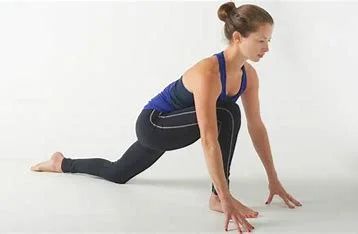
How to perform stretch:
- Start by assuming a lunge position while kneeling on the ground.
- For five to ten seconds, hold this adductor stretch, then let go.
- Do ten to twelve repetitions.
- Standing Lateral Lunge Gracilis Stretch
How to perform stretch:
- Take a wide stance when standing.
- while performing the stretch, keep your posterior pelvic tilt.
- Holding time can be improved in progression.
- Perform this adductor stretch four or five times.
- Butterfly Stretch

How to perform stretch:
- Grab your left foot by reaching forward.
- To aid with the hand-foot joint, you can bend your knee.
- Pull your left foot slowly up toward your groin, bending it until the sole is toward your right thigh and it feels comfortable.
- Let your knees drop toward the floor while keeping your back upright.
- By applying moderate pressure to the knees with the elbows, you can provide mild pressure to the inner thigh.
- You may experience stiffness and tugging in your groin.
- For twenty to thirty seconds, hold the butterfly pose.
- Release and repeat two or three times.
- Half-kneeling adductor dips
How to perform stretch:
- Half-kneeling dips for the adductor
- As much as possible, extend the left leg to the side.
- It’s possible that your foot and knee are at right angles.
- The inside thigh, particularly the right side, is where you may feel the strain.
- Do this eight to ten times.
- Supine Wall Stretch
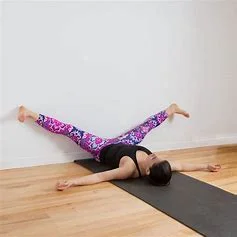
How to perform stretch:
- having one leg propped up against a wall while lying supine in front of it.
- As you go closer to the wall, keep your hamstrings at a comfortable length.
- As they gradually split open, keep your leg straight until you feel the inside side of it expand.
- Unwind and repeat three times.
- Kneeling Gracilis stretch
How to perform stretch:
- The left inner thigh is where you may feel the stretch.
- After 8–10 seconds of pause, release the stretch and return to it.
- Do this eight to ten times.
- Gracilis AIS Release
How to perform stretch:
- Put a resistance strap around one foot and start in a supine position.
- The foot is then actively slid sideways.
- Avoid raising the foot as this may cause the hip flexors to contract.
- Instead, slip the foot.
- Using the resistance strap, slowly pull the foot farther outward toward the end of the exercise.
- You can feel your adductors getting stretched.
- After five to ten seconds of holding the stretch, slide back.
- Do 8–10 repetitions.
- Frogger stretch
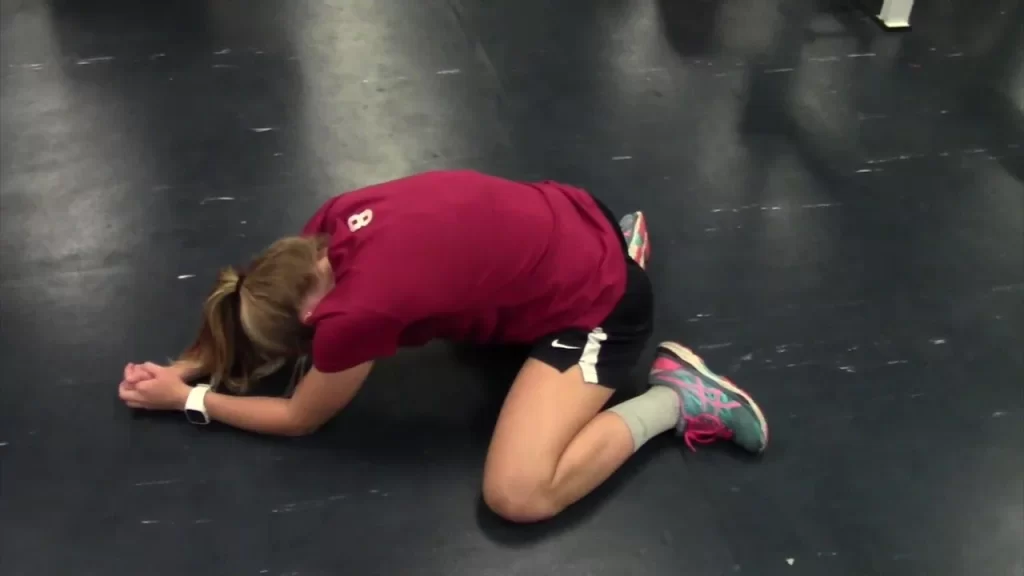
How to perform stretch:
- Feel the strain on the inner thighs as you sit the butt back to the heels.
- After ten to fifteen seconds of pause, release the stretch and return to it.
- Do this eight to ten times.
- Lateral squat
How to perform stretch:
- While maintaining a straight right leg, lower yourself as much as you can.
- Before going back to the starting position, take a breath and hold it for 15 to 20 seconds.
- Crossover Stretch
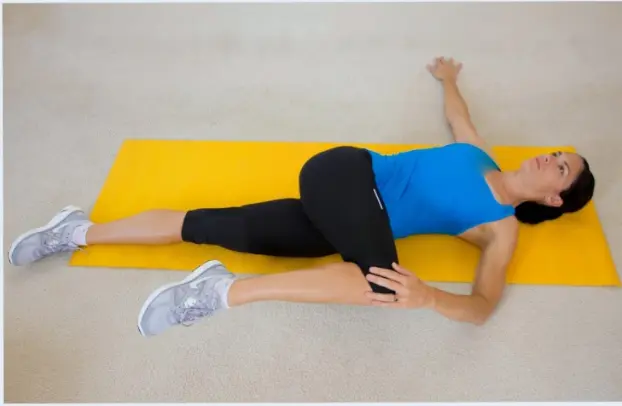
- Since this motion is similar to the “grapevine” dance move, it may come readily to you if you enjoy dancing.
How to perform stretch:
- Put both feet together.
- Bring your left foot to join your right foot and take another step to the right with your right foot.
- Repeat on the other side after both feet are together.
- You can begin slowly and increase your pace as you become accustomed to the movement.
Five to ten times.
- Seated Gracilis Stretch
How to perform stretch:
- Make a “V” shape with the legs straight out to the side.
- Sitting like this is sufficient for many people to extend their inner thighs.
- Lean your hips toward the floor while maintaining a straight back for greater flexibility.
- Hold there for ten to fifteen seconds. Breathe normally.
- Reclining angle bound pose
If you sit for the majority of the day, this is the ideal stretch.
How to perform stretch:
- Draw your soles inward and bend both knees so that their borders meet.
- To feel the groin muscles stretching, lower your knees toward the floor.
- Do this three or four times. With each stretch, attempt to bring the feet closer to the buttocks.
- Squatting Groin Stretch
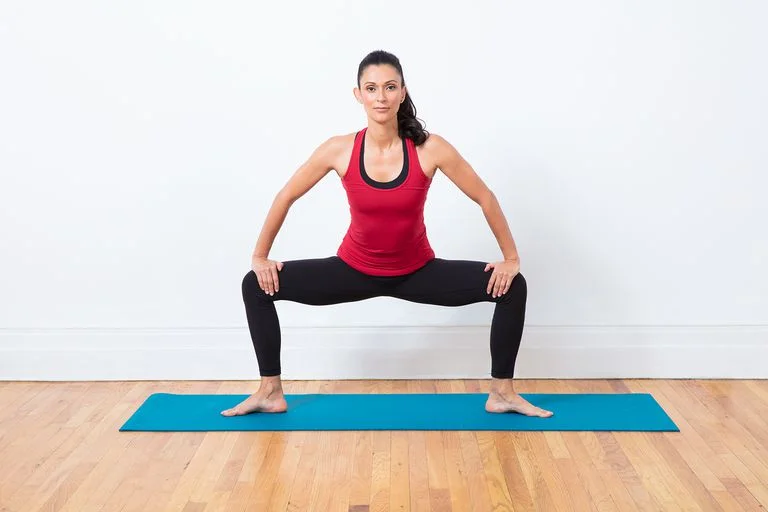
How to perform stretch:
- Squat down gradually until your knees are exactly over your ankles, then bend to a 90-degree angle.
- The inner side of each leg will feel stretched.
- Hip Opener and Groin Stretch
How to perform stretch:
- Drop your right knee to the floor and start in a forward lunge position.
- As seen in the illustration, place the left elbow on the inside of your left knee.
- After holding the stretch for 20 to 30 seconds, let go and repeat with the right leg.
- Runner’s Lunge
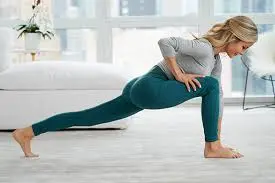
How to perform stretch:
- With your right leg extended behind you and the knee resting or slightly raised, plant your fingertips gently into the floor.
- Keep your head up.
- With each inhalation and exhalation, push your hips farther into the floor.
- Proceed to the opposite sides after that.
- Squatting Groin Stretch
How to perform stretch:
- Squat down gradually until your knees are exactly over your ankles, then bend to a 90-degree angle.
- The inner side of each leg will feel stretched.
- Frog Squat With Arm Raise
How to perform stretch:
- As you stretch the left hand straight up to the roof, fingers pointing upward, keep pushing your inner thigh outward.
- Reach as high as you can while twisting your upper body a little bit further with each breath.
- You may notice a small lift in your right heel.
- Next, flip the opposite sides.
Gracilis muscle Strengthening Exercises:
Multiple tiny muscles in the inner thigh that are in charge of bringing the thighs together, maintaining balance and support, and ensuring good hip alignment are used in gracilis muscle workouts. We are here to disrupt the mindset that most individuals should only think about practicing hip adductor exercises when they pass the gym’s hip adductor machine.
Strengthening the gracilis muscles is crucial for improving stability, preventing leg pains, and increasing mobility and flexibility. Strong abductors are essential for preventing pain as you age, preserving mobility, and doing well in sports. Because they can be challenging to train effectively, the adductors are often disregarded when it comes to strength training.
- Standing Leg Circles
- Side-Lying Hip Adduction
- Squat Side Kick
- Standing side Leg Raise
- Sumo Squat
- Cross Scissors
- Dumbbell Side Lunge
- Cossack Squat
- Copenhagen Side Plank
- Cable Hip Adductor
- Seated Hip Adduction
- Adductor machine
- Wide stance squat
- Standing banded adduction
- Seated banded adduction
- Standing Leg Circles
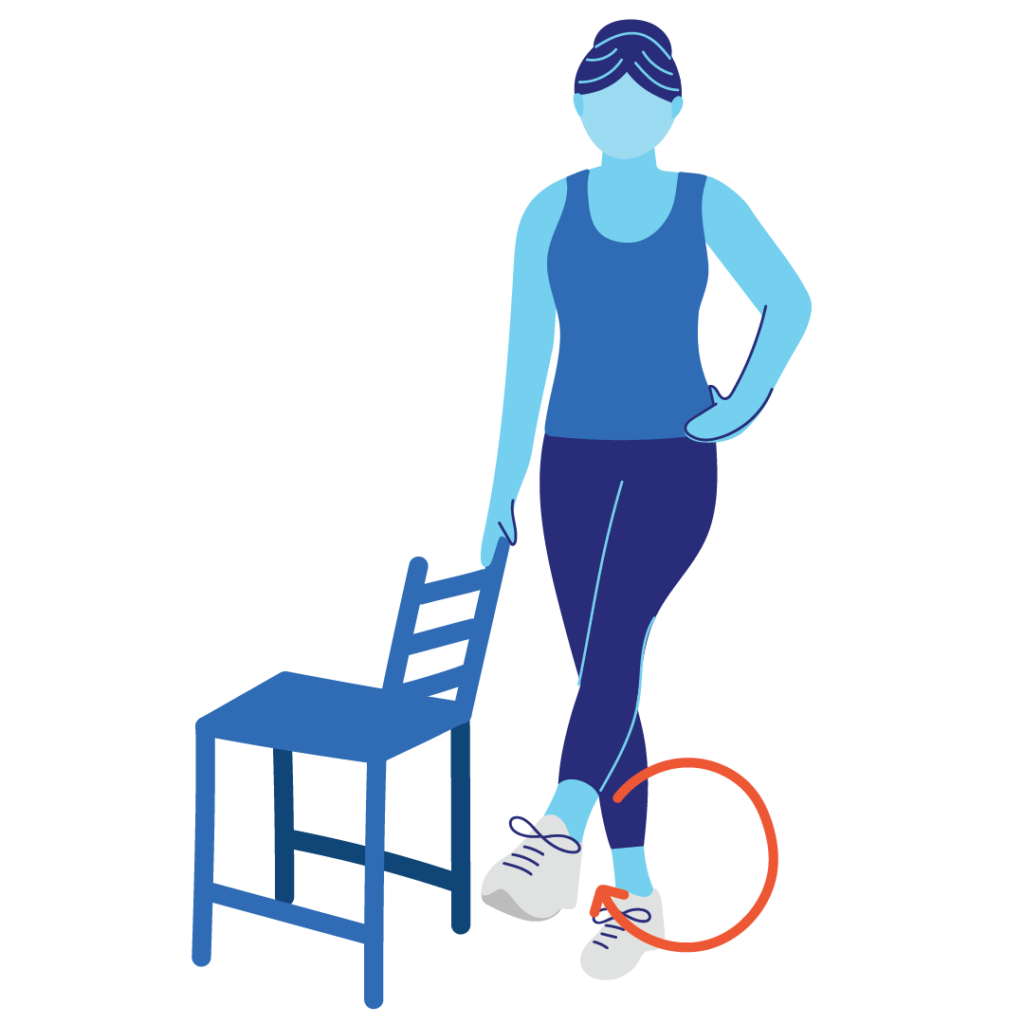
How to do it?
- This rapid warm-up exercise helps to increase blood flow to the upper leg and hip muscles.
- Place your feet hip-width apart for the standing leg circular exercise.
- Lift your left leg off the ground. Make a tiny circle with your left leg while maintaining your balance on your right leg.
- Note: If you struggle with balance, position yourself near a prop that will allow you to support your body with a hand.
- Side-Lying Hip Adduction
How to do it?
- To lift your leg off the ground, simply concentrate on using your hip adductor muscles.
- To perform this exercise, you must lie on your left side with your arms extended in front of you, supporting yourself with your forearm and elbows on the floor. With your heels against the bottom leg’s thigh, lift your right leg over your lower leg.
- Keep your leg outstretched and lift it as high as you can.
- Return to the starting position gradually.
- Perform 10–25 left-side repetitions before switching to the right leg.
- Note: If you struggle with balance, position yourself near a prop that will allow you to support your body with a hand.
- Side-Lying Hip Adduction
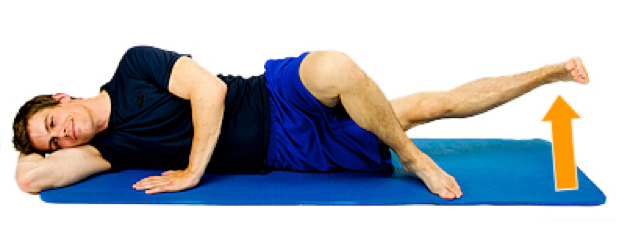
How to do it?
- To lift your leg off the ground, simply concentrate on using your hip adductor muscles.
- To perform this exercise, you must lie on your left side with your arms extended in front of you, supporting yourself with your forearm and elbows on the floor. With your heels against the bottom leg’s thigh, lift your right leg over your lower leg.
- Keep your leg outstretched and lift it as high as you can.
- Return to the starting position gradually.
- Perform 10–25 left-side repetitions before switching to the right leg.
- Note: By strapping an ankle weight to the leg or utilizing a resistance band fastened to an anchor, you can add some provocation to your workout.
- Squat Side Kick
How to do it?
- The squat side kick bodyweight exercise is an excellent lower limb workout that works both the abductors and the adductors.
- This exercise has two movements that allow for both stretching and muscular strengthening, which is crucial to lowering the likelihood of experiencing groin pain.
- To perform the Squat Side Kick exercise, place your hands together in front of you and stand shoulder-width apart.
- Return to the squatting position and do it again with a different leg.
- Keep your back straight, chest up, and avoid letting your knees go past your toes when squatting. This will help your core muscles stay active throughout the exercise.
- Standing side Leg Raise
How to do it?
- Since you will be employing an isometric hold on your other leg to keep it in the air, this is the greatest bodyweight exercise for targeting the hip adductors of one leg while targeting the hip abductors of the other leg.
- You must stand with your shoulders hip-width apart for this exercise. currently standing away from the body on the left leg.
- Next, Raise your right leg as high as you can and stay there for four to six seconds.
- Perform 2-3 sets of 10–18 repetitions.
- Note: Attach ankle weights to both legs to increase the difficulty of this workout.
- Sumo Squat
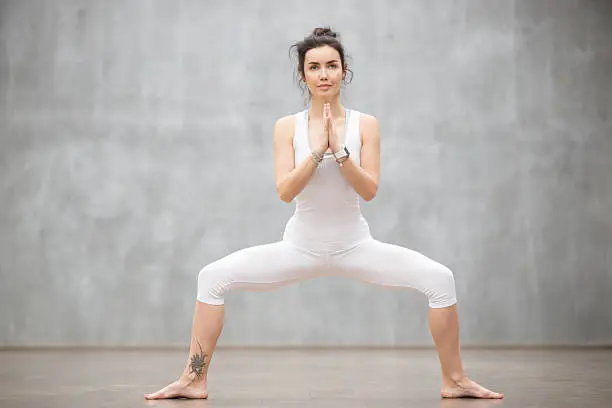
How to do it?
- This squatting version will target the inner thighs as well as the lower limb muscular groups.
- The sumo squat is nevertheless a useful exercise that may be included in regular exercises, despite having a lower range of motion than a standard squat. Drop your hips down and back.
- Return to the starting position after pushing off through the ground.
- Note: Hold a kettlebell in your hand to add some provocation to your workout.
- Cross Scissors
How to do it?
- The ideal exercise for concurrently working the hip adductor muscles and the core is this one.
- Cross-cutting is difficult since you have to maintain a compressed posture during the motion.
- All of your stabilizing muscles must be tensed in order to maintain this position, which involves crossing your legs in front of you.
- With one leg crossed over the other, raise your leg off the ground in front of you at a 30–40 degree angle.
- Throughout the exercise, your core muscle may be used to create a semi-V shape. Extend your legs to the sides and then bring them back together while crossing the other leg.
- Continue doing this with a different leg until you have completed 10–20 reps on each side.
- Note: Sitting in a “V” stance without using your arms to brace the upper limb will make cross-scissors more challenging.
- Dumbbell Side Lunge
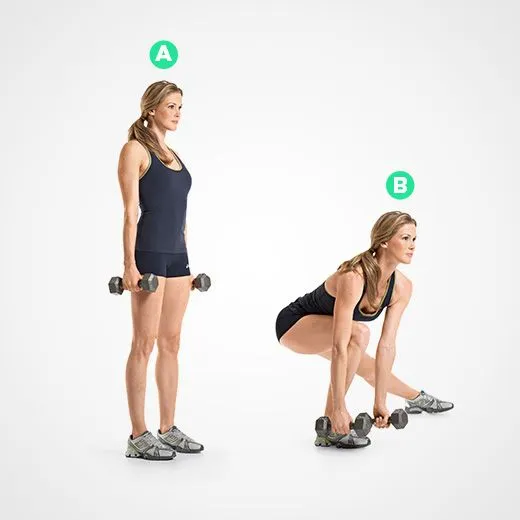
How to do it?
- Stretching and strengthening are two benefits of the side-to-side motion. You can use your hip abductors and hip adductors with the dumbbell side lunge exercise.
- You must hold the dumbbells at chest level and stand with your shoulders hip-width apart for this workout.
- With your foot firmly planted on the ground, take a big step to your side and lower your hip back and down until your thighs are parallel to the floor.
- Bring yourself back to the starting posture by pushing through your flexed foot.
- After ten to fifteen repetitions, proceed to the next leg.
- Note: You can use bodyweight side lunges to make this workout easier. While attempting to avoid bending forward, you may have your chest up and your back in a neutral position.
- Cossack Squat
How to do it?
- The Cossack Squat exercise propels the body side to side in the frontal plane of motion.
- Ankle, knee, and hip flexibility can be increased by working the lower limb at this position.
- By learning this exercise, you will strengthen your hip adductors and obtain a decent stretch, which will boost your stability.
- You must drop your hips back and downward while standing with your feet wide apart and your toes pointed outward for this exercise.
- With your other leg extended out, heels on the floor, toes pointing up, squat down to that one side and redistribute your weight.
- Bring your back to the beginning position after pushing through the ground with your flexed leg.
- Repeat this exercise on the second leg by moving the weight & lowering it down into a squat position on the other side.
- Note: Cossack Squat exercise involves a high degree of mobility thus if you can not get all the way down then go as far as you can while aiming to improve each workout. Throughout the workout, your back may be kept in a neutral position.
- Copenhagen Side Plank
How to do it?
- The most challenging type of plank exercise is the Copenhagen Side Plank, which develops the hip adductors in addition to the core muscles. Strengthening the muscles on the outside of the hip will be balanced with the Copenhagen Side Plank exercise.
- You must lie on the floor perpendicular to the bench for this exercise, then support yourself using your elbows and forearms.
- Place your top leg on the bench after flexing your knee.
- Keep this position.
- After two sets of 20–25 repetitions, switch to the opposite side.
- Note: To make this exercise more challenging, try doing it with your legs outstretched and just your ankle resting on the bench.
- Keep this position.
- After two sets of 20–25 repetitions, switch to the opposite side.
- Note: To make this exercise more challenging, try doing it with your legs outstretched and just your ankle resting on the bench.
- Cable Hip Adductor
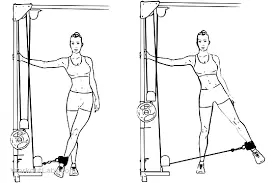
How to do it?
- At the gym, you might see ladies do this exercise while the guys ignore it.
- Everyone may be using this exercise to strengthen their adductors and lower their risk of pain, thus it’s time to dispel the myth that cable hip adductions are not.
- Then, try starting with a lighter weight and a higher number of repetitions until you feel comfortable enough to increase the weight.
- Locate a strap attachment that you may fasten to the ankle nearest the pulley.
- Adjust the pulley at about calf level. Place yourself beside the pulley.
- Adjust the pulley at about calf level. Place yourself beside the pulley. In a secure location where your fingers won’t pinch, brace yourself by placing your hand against the machine.
- Pull your leg toward the center of your body and away from the pulley.
- Allow the leg to slowly return to its initial position. reached the target number of repetitions.
- Note: By fastening a resistance band to a stationary anchor point, the same technique can be used for exercise.
- Seated Hip Adduction
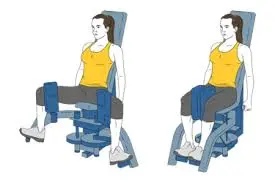
How to do it?
- When you are seated, the seated hip adduction will isolate the hip adductor muscles, requiring you to concentrate solely on bringing your thighs together.
- At the end of your leg day, after you’ve finished the larger compound lifts like squats, add the Seated Hip Adduction exercise.
- Place your back against the backrest while seated in the machine.
- Adjust the knee pads’ breadth to a comfortable level that stretches the inner thighs without overstretching the adductor muscles.
- To avoid going overboard, set up a lightweight for the first time.
- As you exhale, squeeze your thighs together until your knees meet in the middle of your body.
- Return to the starting position gradually.
- Perform as many repetitions as possible.
- Adductor machine
How to do it?
- When most people think of isolation, they might picture the traditional adductor machine used at gyms all over the world.
- Even though this machine is the most effective at training the adductor, there are other movements that can have positive outcomes.
- This workout is excellent for beginners because you can adjust the weight and pad width. Starting out really light is the greatest way to gain a feel for the workout and prevent pain.
- You must first sit on the machine with the pads as wide apart between your legs as comfortable, then choose the resistance level that best suits your ability.
- Tighten your thighs together gently until the pads make contact while you can feel your muscles flex.
- Return your thighs to the starting position by slowly reversing the motion. Do as many sets and repetitions of this exercise as possible.
- Try two or three sets of ten reps if you’re just starting.
- Wide stance squat
How to do it?
- One of the best leg workouts that will work your entire leg is the squat.
- There are other squat varieties, but in this article we’ll talk about the wide stance squat, often known as the sumo squat, which works the muscles in the inner thighs.
- This exercise can be performed with body weight alone or with a variety of weighted equipment, such as a barbell, kettlebell, dumbbell, or sandbag.
- You must stand slightly wider than shoulder-width apart and turn your toes out for the wide stance squat exercise.
- Lower your hips gradually until your thighs are parallel to the floor by shifting your weight backward.
- Your inner thigh muscles are then tensed as you push through the ground to return to the beginning position.
- Perform 2-3 sets of 10–15 repetitions.
- Standing banded adduction
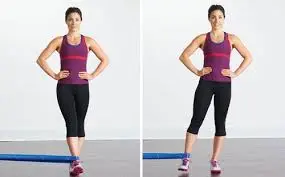
How to do it?
- A resistance band is required for this exercise, and it should be wrapped around a sturdy anchor. You must face the resistance band and the anchor point while standing on each side of your body.
- By opposing the movement, let the resistance band pull the leg to the side.
- You must stand erect and move a banded leg toward your body’s midline to begin this workout. You should feel a nice contraction in your inner thighs.
- Release your leg slowly and controllably back to the side.
- Do three to four sets of 10 to 20 repetitions on each leg after switching legs.
- Seated banded adduction
How to do it?
- A resistance band is required for the Seated Banded Adduction exercise. It should be wrapped around a sturdy anchor.
- You must face the resistance band and the anchor point while seated on the bench on each side of your torso.
- The resistance band is placed right below the knee joint; insert the internal foot through it. Permit the leg to be drawn toward the anchor point by the resistance band.
- Contracting the adductor muscle will move your leg toward the middle of your body.
- Do this again for each leg.
- Lateral Lunge
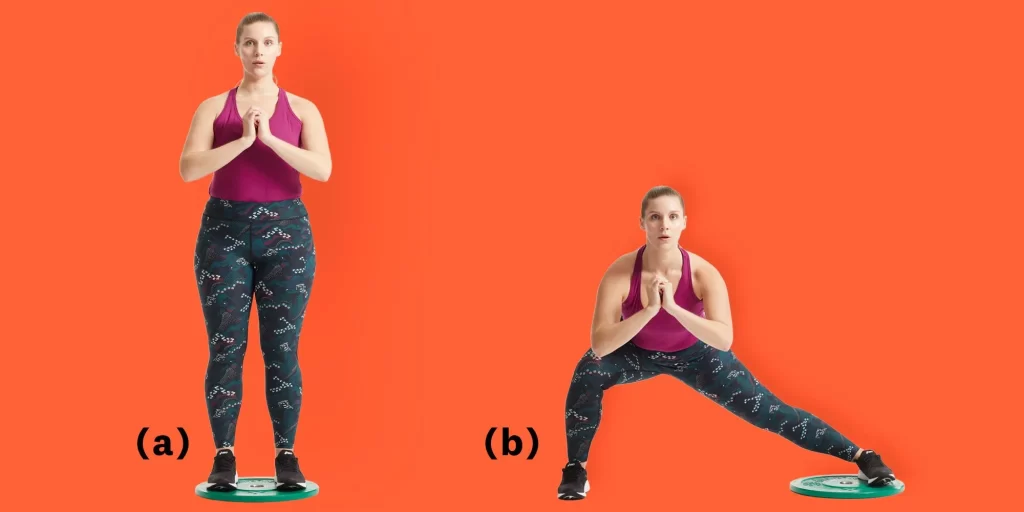
How to do it?
- You must place your feet hip-width apart in order to perform the Lateral Lunge exercise. Start by flexing your left knee while stepping out of your left leg and sending your hip back.
- Your knee should be in line between your second and third toes during the descent, and it shouldn’t go more than two inches past them.
- The toe somewhat extends outward. To get back to the starting position, push off through the left.
- To finish the first repetitions, repeat on the right leg.
- On each leg, perform three to four sets of eight to ten repetitions.
When did you not complete this task?
- if you were told to rest by your healthcare physician.
- if you currently have knee and back pain.
- if you recently had a fractured lower limb bone.
- if this workout causes you any pain.
How to prevent Gracilis muscle pain?
- Gracilis strain can be excruciating and prevent you from engaging in your favorite pastimes.
- You can help avoid gracilis pulls caused by strains in a few ways:
- Prior to engaging in any physical exercise, warm up your groin and leg muscles. Muscle stains can be prevented by engaging in activities that raise your body temperature, such as a light jog.
- For optimal support, put on comfortable shoes.
- Gradually increase the training’s intensity.
- If you have tightness or soreness in the inside of your thigh or groin, stop exercising.
- Regularly strengthen your thigh muscles, particularly if you’ve previously experienced a groin strain.
- Consult your physician about other measures to reduce the risk of groin strain.
- A recurrent issue could arise from subsequent Gracilis strains. Therefore, both primary and secondary prevention are equally crucial. The intrinsic and extrinsic risk factors for the pain type must be understood in order to identify the athlete who is at risk and potentially address the predisposing condition.
- An increased likelihood of new groin pain is linked to lower levels of sports-specific training, higher levels of play, decreased hip adduction strength, and prior gracilis pains. Hölmich et al. showed that chronic groin strains could be effectively treated with an 8–12 week active strengthening program that included progressive resistive adduction and abduction exercises, balance training, abdominal strengthening, and skating movements on a slide board. The preventative program also includes core stability exercises, eccentric exercises, and coordination exercises (which target the muscles associated with the pelvis).
FAQs
How can gracilis muscle pain be treated?
Apply ice packs or give yourself a massage. Before beginning the stretching and strengthening exercises that your doctor, physical therapist, or athletic trainer has recommended, you may apply heat. Apply a warm soak or a heat pack.
What’s the name of the gracilis exercise?
Butterfly Isometric Exercise
A few inches in front of your body, place the bottoms of your feet together on the floor while lying on your back and flexing your knees. For at least five seconds, have your partner kneel in front of you and press his hands on the insides of your knees.
What is a biopsy of the gracilis muscle?
The gracilis muscle motor nerve biopsy is a straightforward process. Its rate of complications is tolerably low. None of the patients reported of more weakness or sensory loss as a result of the biopsy, despite the fact that most of them already had impairment from their underlying condition.
What is gracilis commonly known as?
Eastern Mexico is home to the species Galphimia gracilis, which belongs to the genus Galphimia in the family Malpighiaceae. Common names for it include “gold shower,” “shower-of-gold,” “slender goldshower,” and even “thryallis.” It is extensively grown in warm climates all over the world.
What are the gracilis muscle’s trigger points?
The Trigger Point of Gracilis
The thigh, ankle, and foot contain the gracilis muscle’s trigger sites. Medial thigh pain is the main symptom of transferred pain, while anteromedial knee pain is the secondary sign.
How much time does it take for a gracilis strain to recover?
A person with grade 1 strains will need to rest for one to two weeks before they can resume their activity routine. Within a few days, you should be able to walk and move normally. It could take three to six weeks for grade 2 strains to completely heal. When most or all of the muscle is torn, a grade 3 strain occurs.
Why does my gracilis hurt?
If the bursa beneath the sartorius, gracilis, and semitendinosus tendons becomes inflamed due to direct trauma, overuse, or pain, an individual may develop this condition, which is typically caused by overuse in athletes and is a common cause of persistent knee weakness and pain.
Is the muscle gracilis deep?
Within the medial (adductor) compartment of the thigh, the gracilis is the most superficial muscle. The skin and subcutaneous tissue cover it superficially, while the deep layer of fascia lata covers its medial portion as well.
How can the gracilis muscle be relaxed?
Sit on the floor with your legs straight out in front of you and your back securely pressed against a wall to stretch the Gracilis muscle. Drop your foot toward the floor and spread your legs as wide as you can.
What is a sickness of the gracilis muscle?
Traumatic osteitis pubis and pain to the adductor longus muscle origin are similar to the “gracilis syndrome,” a fatigue fracture of traumatic aetiology involving the bone origin of the gracilis muscle at the pubic symphysis.
What is the sensation of a strained gracilis?
Symptoms of a Potential Gracilis pain
An pain to the gracilis muscle can cause knee pain in addition to groin or thigh pain. Still, gracilis dysfunction can also cause knee pain. Depending on the kind of groin pain, muscle weakness and even bruises may be present.
What is the duration of the healing process for gracilis?
Conclusion: A gracilis muscle rupture should be suspected if there is pain in the medial thighs following an eccentric contraction during hip adduction. Full recovery from the damage happens within six weeks, and ultrasound is helpful.
How can gracilis muscle pain be prevented?
Handling and Therapy
Rest: To prevent further pain to your muscle, stop the physical activity that generated the strain.
Ice.
Compression: Compression minimizes swelling and lowers blood flow to your affected muscle.
References
- Valand, B. (2022, August 26). Gracilis muscle pain – Cause, Symptoms, Treatment, Exercise. Samarpan Physiotherapy Clinic. https://samarpanphysioclinic.com/gracilis-muscle-pain/
- Gracilis Muscle pain: causes, stretches, strength exercises | ISSA. (n.d.). https://www.issaonline.com/blog/post/gracilis-muscle-pain-causes-stretches-strength-exercises

